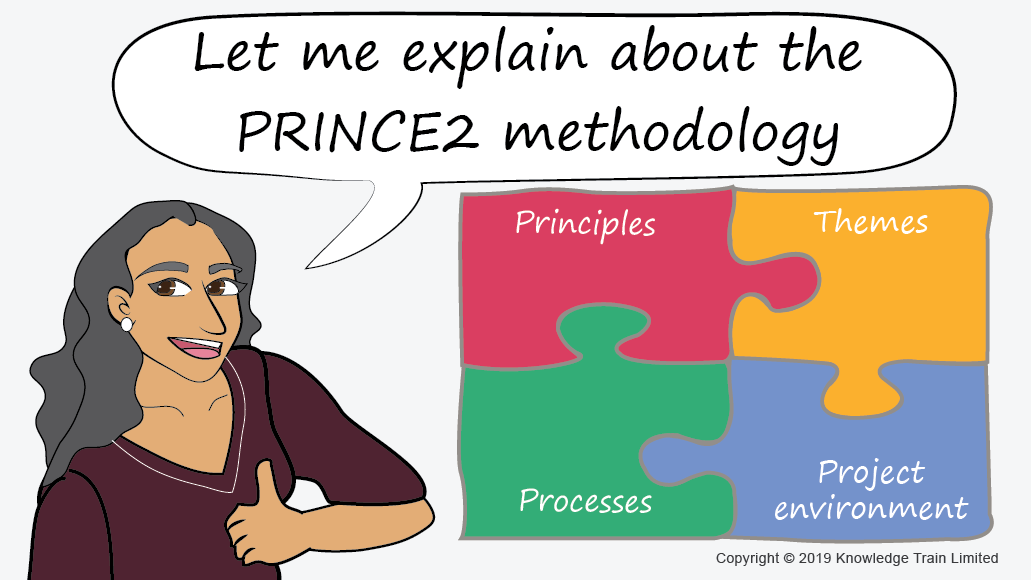
PRINCE2 methodology - introduction
PRINCE2 is the world’s leading structured project management methodology. PRINCE2 is structured to provide clear guidance about the best ways to manage projects. It helps organizations get better control over projects and better return on investment.The PRINCE2 method is structured into 7 well-defined processes to address typical project management needs.PRINCE2 consists of 4 integrated elements:- Principles
- Themes
- Processes
- Tailoring to the project environment.
PRINCE2 methodology - principles
The 7 PRINCE2 principles are: 1. Continued business justification Justify every project otherwise it could be a waste of time and/or resources. Even compulsory projects need justification. 2. Learn from experience Enables organisations to improve their project management abilities. Avoid repeating bad things from previous projects. Repeat the good things. 3. Define roles and responsibilities Every decision-maker must understand their responsibilities. This avoids ‘passing the buck’. 4. Manage by stages Break down the project into 'management' stages. These form 'go or no-go' decision points. If the project is still worthwhile, proceed to the next stage. Otherwise close the project. 5. Manage by exception In PRINCE2 Senior management delegates day-to-day responsibility to a project manager. It delegates authority by setting permitted 'tolerances' – e.g. 10 days +/- 2 days. If a plan will exceed tolerances, it's an 'exception' to be escalated for a decision. 6. Focus on products The project must deliver the right outputs to achieve the desired outcomes. When planning, focus on whether the products will meet the users' needs. 7. Tailor to the project environment. All projects are different. Adapt the PRINCE2 methodology to suit the project's needs.PRINCE2 methodology - themes
Themes in the PRINCE2 method are project management areas which must be managed throughout the project. In the PRINCE2 methodology themes equate to Knowledge Areas in the PMBOK Guide® [1]. The PRINCE2 method has 7 themes:1. Business case Document the project's justification. Maintain the justification in the form of a business case. It should contain a cost-benefit analysis to to weigh up the benefits versus costs, times and risks.2. Organization The highest level of decision-making is the project board. It delegates to a project manager who delegates to team managers. It 'manages by exception' and doesn’t need regular progress meetings with the project manager. Project assurance monitors the project’s performance and products. It advises the project board and project manager. A change authority decides about changes. Project support assists project and team managers.3. Quality The users must get the right products. Otherwise, they won't get the outcomes and benefits expected. Products must be delivered to user specifications.4. Plans Different plans (project, stage, team) are needed by the project board, project and team manager. Plans define the what, when, who and how much? After approval manage baseline plans under change control.5. Risk Risk is any uncertain event which could have a negative or positive impact on the project. Manage risks regularly. Escalate risks to senior management if necessary.6. Change Change always happens - either from outside (e.g. new laws) or inside (e.g. users’ requirements change). In PRINCE2 a change authority uses a change budget to pay for changes.7. Progress Track progress using regular time-driven reports. Take decisions using ad-hoc reports. Send reports to the next highest management level. Compare what's happened against what should have happened. Adjust the plan to get things 'back on track'.PRINCE2 methodology - processes
Processes in PRINCE2 describe:- What decisions are required?
- Who takes decisions?
- What management products (e.g. plans or reports) support decision-making?
- When decisions are taken?
PRINCE2 methodology - tailoring
The PRINCE2 methodology must be adapted to meet the unique needs of each project by applying the ‘tailor to the environment’ principle. When tailoring, consider the project’s scale, geography, complexity and level of risk, and the organisation maturity and corporate culture.Summary
PRINCE2 is a proven methodology used by organisations globally for over 20 years. It is continuously being improved as project management practices evolve. To learn more, consider taking a PRINCE2 course to gain understanding of this successful project management methodology. [1] The PMBOK Guide® (from the Project Management Institute (PMI®) is a project management standard describing project management techniques, processes and knowledge areas. PMI and the PMBOK are registered marks of Project Management Institute, Inc.Infographic

